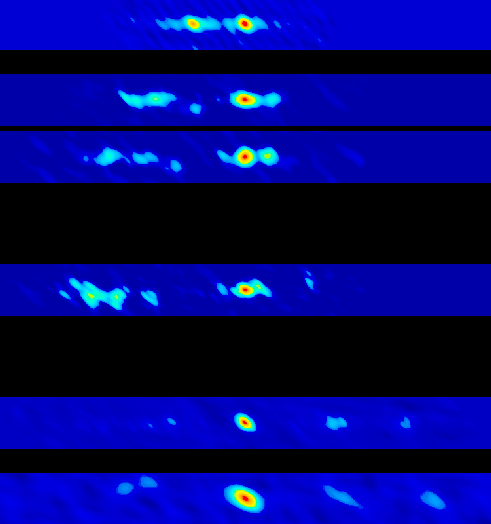

Movie from high resolution radio VLBA data of GRO J1655-40 reveals rapid ejections. See also earlier VLBI image sequence (or contour plot).
Soon after an x-ray burst was observed with the Gamma-Ray Observatory (GRO) radio VLBI observations of GROJ1655-40 revealed evidence of rapid plasma jet ejection. These properties are typical of quasars, and serve as mounting evidence that quasars aren't extra-galactic as most cosmologists would have us believe.
The star, identified as GRO J1655-40, was discovered using NASA's Gamma Ray Observatory on July 27, 1994, when it underwent such a strong outburst of x-rays that it quickly became the strongest x-ray source in the sky, said Jet Propulsion Laboratory astronomer Dr. Robert Preston, a member of the observing team which began tracking the object shortly after its discovery.
"The star exhibited some exotic behavior," Preston said, "ejecting material at 80 percent of the speed of light just like very powerful quasars. This suggests that the object is likely to be powered by a black hole or neutron star."
Black holes are thought to occur at the end of the lifetime of a massive star, when the outward pressure of the star's diminishing radiation can no longer prevent the gravitational collapse of the star into a vanishingly small volume. Quasars are believed to contain enormous black holes with masses of up to billions of times that of the Sun. A neutron star is a less dense form of a collapsed old star, but still has a density of more than a billion tons per teaspoon of material.
The discovery represents only the second time that such an object has been found in Earth's own galactic neighborhood. The observations were made possible by a technique called interferometry, in which several radio telescopes are used simultaneously to synthesize one enormous telescope.
The extremely energetic star was estimated to be about 12,000 light-years from Earth, or about 15 percent of the way across the Milky Way galaxy, said Preston, whose findings appeared in this week's issue of the science journal Nature.
The team believes that the collapsed star -- observed in the radio portion of the electromagnetic spectrum -- is not a single star but rather two stars in orbit about each other. They speculate that material may have been drawn off one of the stars to form a disc that spiraled into the other star, which is probably a black hole or neutron star.
Their radio observations, surprisingly, revealed that the ejection of matter from the star did not start until 12 days after the beginning of the violent x-ray outburst.
"The enormous outburst could be caused by an unusually large piece of the companion star falling onto the compact star, with the subsequent expansion of the jets of matter being ejected perpendicularly from the center of the disc," Preston said. "The influx of material was so great during the x-ray outburst that it may have disrupted the production of jets, thus causing the observed delay in the formation of jets until the flow of material had diminished."
The fact that radio jets did not emerge until x-ray emissions had subsided may be an important clue to the nature of jet production, not only in similar objects but also in the much more luminous and massive objects found in distant quasars at the edge of the universe, the team reported.
"Since quasars are found at distances of up to almost a million times farther away than this x-ray star, astronomers now have an opportunity to study a similar process in much greater detail," Preston and his colleagues said.
The team of radio astronomers reporting this discovery were from the Jet Propulsion Laboratory and several other institutions in Australia and South Africa. Their observations were made using an array of radio telescopes located at various sites across the world, including telescopes at NASA's Deep Space Network in both California and Australia.
The research were sponsored in part by the Astrophysics Division of NASA's Office of Space Science, Washington, D.C.
PUBLIC INFORMATION OFFICE JET PROPULSION LABORATORY CALIFORNIA INSTITUTE OF TECHNOLOGY NATIONAL AERONAUTICS AND SPACE ADMINISTRATION PASADENA, CALIF. 91109. TELEPHONE (818) 354-5011Contact: Diane Ainsworth
FOR IMMEDIATE RELEASE (#9519) March 14, 1995
(There is a more recent January 12, 1995 press release)